#cornell music academy
Explore tagged Tumblr posts
Text
youtube
I am an Old, so I completely grew up with this and it’s one of the stickiest of my Sesame Street memories (sn: SS used to be so delightfully surrealist with its animations - I have a small collection of especially cherished ones and they are every bit as trippy and bizarre to my adult eyes as they were in childhood).
Anyway … this is a fascinating musical analysis of the pinball counting song (Pointer Sisters, yeah!!)
#sesame street#pinball counting song#pointer sisters#one two three FOUR FIVE six seven eight NINE TEN eleven twelve#cornell music academy#charles cornell#Youtube
2 notes
·
View notes
Text
‘As Pure and Raw As It Can Get’: The Pretty Reckless’s Going to Hell Turns 10
Taylor Momsen and Ben Phillips recall the tragedy-to-triumph story of the band’s second studio LP, released on March 12, 2014

Taylor Momsen and The Pretty Reckless perform during the 2014 iHeartRadio Music Festival Village on September 20, 2014 in Las Vegas. (Credit: Isaac Brekken/Getty Images for iHeartMedia)
It was the best of times, it was the worst of times—the making of The Pretty Reckless’s Going to Hell, that is. As the band’s second studio album celebrates its 10-year anniversary, frontwoman Taylor Momsen and guitarist Ben Phillips recall the epic and often heartbreaking journey of its creation—and surprising success, against the odds. “I think that it’s a story of triumph in a lot of ways,” Taylor says. “To see it become so successful when that wasn’t the intention is a little surreal, to say the least.”
The triumph part is easy. Four years after their studio debut Light Me Up (“Make Me Wanna Die” its hit lead single) established them as a band of definitive talent, The Pretty Reckless set out to create an album that reflected their shared love for the same fiery sound—with zero interest in topping anyone’s charts. The result was Going to Hell, an album best described in any room as unapologetic. Untamed and gut-wrenching also apply, as well as thoughtful, deliberate, and empowering—showcased by Taylor’s fierce and flawless voice, one perfectly suited for hard rock ‘n roll.
For perspective, in 2014 the Frozen soundtrack boasted the longest-running No. 1 album, with Pharrell Williams’ sticky, bop-along “Happy” Billboard’s No. 1 song of the year. And then here comes Going to Hell, flame-throwing itself onto Billboard’s No. 5 spot upon its release. “We melted Frozen,” Ben remarks, and he and Taylor break out in laughter.

Bassist Mark Damon, Taylor Momsen and the band on stage at London’d Brixton Academy on November 26, 2014. (Credit: Christie Goodwin/Redferns via Getty Images)
Clearly, the intention wasn’t to create a commercial album, and Ben goes so far as to recall when he and producer Kato Khandwala first met Taylor and how authentically “non-commercial” she was.
“She wanted to be Chris Cornell, and she didn’t care about anything else,” Ben says. “We don’t even know what a hit is in this band.”
As Ben recalls, Taylor and Kato met first, and it was established that Taylor “didn’t want to write songs for the record label or for [an] audience or for the whatever. She had songs that she wanted to write, and that meant that you had to be an artist about it. No one ever hears our records till they’re mastered and finished. That’s the first thing. No one. We’re not looking at the radio, we’re not looking at anything. We just create in the studio.” The 15/16-year-old Taylor that ignited Light Me Up wasn’t the same as the 18/19-year-old Taylor behind Going to Hell. “She’d stepped into maturity,” Ben says.
Going to Hell started with the best of intentions. Gone were the “childish pretensions��� and “a whole mess of music industry stuff we weren’t expecting” of their studio debut, according to Ben. Kato had put together a new studio for them—Hoboken, New Jersey’s Water Music Recording Studio—and they “worked on songs as they came, in a vacuum making our music and not knowing what anyone else was doing,” Ben says. Also present were bandmates Mark Damon on bass and Jamie Perkins on drums. Working as a unified, creative force, these were the best of times. But then, in October of 2012, Hurricane Sandy came and destroyed the studio. They relocated to Lake Hopatcong (also in New Jersey) to finish up.
“There’s no songs on this for radio or anything,” Ben thought, at the time, and they were happy with what they believed to be an honest, authentically non-commercial album. Taylor agreed, definitively, remembering: “This is not a hit record.”

Taylor and Ben before a live performance at London’s Electric Ballroom, March 24, 2014. (Credit: Rob Monk/Total Guitar Magazine/Future via Getty Images)
Ben refers to the album as a “dark record about Taylor removing herself from her childhood, growing out of her upbringing…identifying with all her childhood mistakes and everything that she had done.” Aside from its obvious dark themes, the album was written in actual darkness, during the 2012 NYC blackout, Taylor sitting in her apartment surrounded by candles. “I was sitting in the freezing cold writing ‘Going to Hell,’ Taylor says, of the single that eventually became the theme of the entire project. Though they initially wanted “Going to Hell” to be the album’s first single, they went with “Heaven Knows,” released on November 13, 2013, and it would become the band’s first No. 1 on Billboard’s Mainstream Rock Songs chart. “Messed Up World (F’d Up World)” and “Follow Me Down” followed in chart-topping suit.
No one was more surprised than The Pretty Reckless. “We never had any radio [play] in America, so we didn’t even think that was a possibility,” Ben says. They clearly struck an unexpected chord. A “heavy and dark” chord at that, according to Taylor. Going to Hell was already a hit.
Taylor and Ben attribute the artistic and unanticipated commercial success of Going to Hell to being a cohesive unit.
“Possibilities were endless… musically we were on the same page,” Taylor says. This, of course, included Kato who, according to both of them, was at his creative height on Going to Hell. Aside from Hurricane Sandy drowning their studio in six feet of sewage, and, in Taylor’s words other “devastating outside forces” during the making of the album, Kato’s wife Lisa passed away at the end of the year. It was Lisa who’d come into the studio with Q-Tips and, as Ben recalls, “cleaned every guitar from screw to screw for us, bringing them all back to life.” Going to Hell is dedicated to Lisa.
This devastating loss signaled a definite shift. In an attempt to help Kato through the tragedy of Lisa’s passing, they brought him back into the studio to work on the last single, “Messed Up World (F’d Up World),” a song that Taylor says “sums up the whole thing.” Kato, their cherished collaborator who Ben referred to as “our best friend,” died in 2018 as the result of a motorcycle accident.
As Ben says, losing Kato meant trying to navigate future projects without him, moving forward: “We had to rebuild and figure out how we were going to do this without him.”
Taylor adds: “[Kato was] a conduit for our songwriting and our creativity. He got inside what Ben and I were writing and helped to make that vision come to life in a really deep and involved way.” Going to Hell, she continues, “changed our lives. Even though we maybe didn’t see it at the time, we certainly are feeling the effects of it to this day. First, it made us double down on our ethics. It gave us the confidence to go, ‘We’re doing the right thing by doing it this way,’ and continued us on the path that we’re still on.”
“It’s ups and downs, but…that’s life,” Ben says.
“That’s the life,” Taylor says. “It’s a perpetual, lifelong sacrifice to be a songwriter and to be true to yourself.”

From his 125th Street Harlem studio, photographer Danny Hastings, best known for his legendary hip-hop album covers (Enter the Wu-Tang: 36 Chambers, Eminem’s Slim Shady special edition, among others), shot a naked and painted Taylor over the course of 16 hours.
Determined to preserve authenticity, and inspired by the classics, Taylor and team were committed to capturing the Going to Hell cover image in its entirety on camera. That meant, the now-famed downward-pointing arrow/cross was painted on Taylor on site, a task that took time, but was well worth it, in the spirit of iconic covers of the past. As Taylor explains, the idea came from the famous 1996 Pink Floyd promo poster shot by Tony May featuring six naked women sitting by a pool, their backs painted with the band’s cover art. (Eric Clapton’s E.C. Was Here and Pink Floyd’s Wish You Were Here, where a man was actually lit on fire, served as further inspiration.)
“It’s kind of a homage to love, with a new take on it,” Taylor explains. “Because the cross was something that I had drawn myself and come up with. I was like, ‘This is the physical representation of this record to me, this is the symbol.’” Visuals, she says, come naturally to her, “especially when making music.” (She says she sees music visually, too.)
“I was drawing [the cross] while we were recording the record, and I was like, “Well, this is the logo, this is the symbol for this record and so let’s put it on my back and use sensuality and sexuality.”

An outtake from the Going to Hell photo shoot. (Credit: Danny Hastings)
The artist hired to apply the graphic on Taylor was familiar with the band, but not Taylor and her former acting career — in the beginning. “As he was painting my nipples very detailed and it’s specifically my nipple…that’s what’s funny about this…he’s leaning in…creating every little speck and dot perfectly. He puts together that I was Cindy Lou Who [in 2000’s How the Grinch Stole Christmas], and this guy drops his paintbrush, starts spinning around the room, screaming, going, ‘I can’t believe I’m painting Cindy Lou Who!’” Taylor says. It provided some “much-needed comic relief [for] this very serious project.”
As to not distract from the music, Taylor’s face is intentionally not shown. They thought of every detail, including the redness under the right elbow. “It’s getting scorched by flames you can’t see as I’m reaching down to hell, being tugged,” Taylor says.
To achieve the final image—Taylor’s body curved just so, arms forward in gentle balletic motion—the inky graphic had to be painted perfectly and, according to Ben, she had to angle her body a certain way, to achieve, in Taylor’s words, “a piece of art.”
The result is an astute personality test for any onlooker: Is the woman in the picture actually going to hell – or emerging from it?
“This is me as pure and raw as it can get,” Taylor says. “Kind of how I feel about this album.”
9 notes
·
View notes
Text
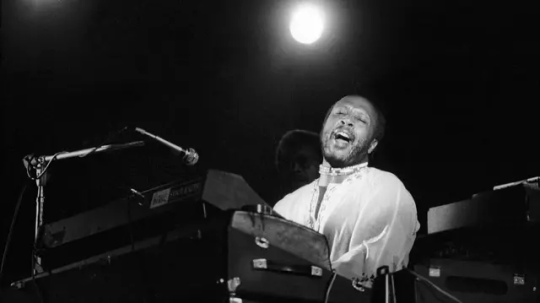
Les McCann was already an established solo artist — a blues-forward jazz pianist in his 30s, with more than two dozen albums to his name — when he had a career-defining moment at the 1969 Montreux Jazz Festival. There, during an impromptu jam with the saxophonist Eddie Harris, he dug into a new song by his friend Gene McDaniels, which struck a cultural nerve.
The song was "Compared to What," an anguished yawp of disillusionment that Roberta Flack had recorded several months earlier for her debut album, First Take. McCann begins his version with a rollicking vamp, which he takes through a handful of escalating key modulations before a startling entry on vocals, two minutes in. With a soulful holler, he brings plainspoken fire to lyrics that skewer rampant greed, religious hypocrisy and the quagmire in Vietnam: "The president, he's got his war," McCann sings in the third verse. "Folks don't know just what it's for."
youtube
The song's temperament, outraged and despairing, captured something crucial about the era; so too did its rhythmic drive and righteous, consuming fervor. When Atlantic Records released "Compared to What" as a single, it spent four weeks on the Billboard Hot 100; Swiss Movement, the live album on which it appears, held a spot on the Billboard 200 for 38 weeks. The song remained a calling card for McCann for the rest of his musical career, which yielded many more successful albums — including a sequel with Harris, Second Movement, in 1971 — as well as samples by hip-hop artists like Massive Attack, Mobb Deep and The Notorious B.I.G.
McCann died on Dec. 29, 2023, at a hospital in Los Angeles, at 88, of pneumonia. Alan Abrahams, a veteran producer and record executive who served as his manager, confirmed his death, noting that McCann had lived at a nursing facility for the last four years.
With a ringing, percussive piano style and a rousing command of the beat, McCann always amounted to more than one breakout hit could encapsulate. The grit and grease in his playing, informed by his early experience in the gospel church, helped establish the subgenre known as soul jazz. That sound is already fully present on an album he recorded live in 1961, Les McCann Ltd. Plays the Shampoo at The Village Gate. (Along with "The Shampoo," an early hit, it includes McCann originals titled "Someone Stole My Chitlins" and "Filet of Soul.")
The urge to move his audiences extended to a new sonic palette when McCann embraced electric pianos and synthesizers — notably on the 1972 album Invitation to Openness, which features Yusef Lateef on assorted reeds and flutes, and Cornell Dupree on electric guitar. His subsequent albums with Atlantic, often incorporating synths and clavinet, formed the basis for his popularity as a sample source for hip-hop producers.
Leslie Coleman McCann was born on Sept. 23, 1935, in Lexington, Ky. His father, James, worked at the Lexington Water Company; his mother, Anna, was a homemaker who took occasional housekeeping jobs. He was one of six children, with four brothers and a sister. "Everybody was in a position of doing the best they could with whatever," he recalled in a 2015 interview with Red Bull Music Academy. "We never thought of ourselves as being poor."
Still, McCann grew up with limited resources, and was almost entirely self-taught as a pianist. He played sousaphone and drums in his high school marching band, and enlisted in the U.S. Navy at age 17. He often told a story about hearing Erroll Garner's recording of "Lullaby of Birdland" during his service, and having the sudden realization that the piano was his calling. But while stationed in the San Francisco Bay Area, he won a talent contest as a vocalist — an accolade that landed him an appearance on The Ed Sullivan Show in 1956.
After his discharge, he formed a piano trio, which found work backing Gene McDaniels at the Purple Onion jazz club in San Francisco. McDaniels took the trio on tour, after which McCann moved to Los Angeles, working at clubs like the Hillcrest and signing to the Pacific Jazz label. The band that he called Les McCann Ltd. recorded a string of surefooted albums, and also played on the debut album by the jazz-R&B singer Lou Rawls, in 1962.
McCann eventually left the Pacific Jazz roster for Limelight, a Mercury subsidiary overseen by Quincy Jones, before landing at Atlantic Records. There his partnership with the producer Joel Dorn yielded a number of successes, starting with the 1969 album Much Les. Featuring McCann's electric piano against a complement of strings, the album also spotlighted his vocals, notably on a ballad called "With These Hands," which became a hit.
Here and throughout his career, McCann faced enduring critiques of his piano playing, which lacked the outward sophistication and technical precision of some of his peers, especially those who'd mastered the lingua franca of bebop. "I think what Les did musically, for most of his career, was really brave," attests Joe Alterman, a pianist who regarded McCann as a mentor, and released an album in tribute last year. "He wasn't a bebop player. He appreciated it, but he really loved these joyful piano players. So I think Les was kind of going against the grain."
McCann's most recent release, just out on Resonance Records, bolsters the point. Titled Never a Dull Moment! Live From Coast to Coast 1966-67, it features a few effervescent trio dates from the same era, at the Penthouse in Seattle (1966) and the Village Vanguard in New York (1967). There are, in fact, some bebop tunes, like Dizzy Gillespie's "Blue 'n' Boogie," in the set list. But the spirit of the playing has little room for bebop's idiomatic concerns. It adheres instead to a characterization of McCann from Bob Porter's 2016 book Soul Jazz: Jazz in the Black Community, 1945-1975, as "a pianist of enormously contagious enthusiasm."
McCann was certainly that, and more besides. He had a good ear for talent: He was the one who brought Roberta Flack to Atlantic, and he is credited with discovering the soul-jazz organist Richard "Groove" Holmes. And he was a gifted photographer whose portraits were anthologized in the acclaimed 2015 collection Invitation To Openness: The Jazz & Soul Photography Of Les McCann 1960-1980.
At the same time, McCann held a steadfast devotion to certain core principles, in music as in life. "The blues is definitely one of my major religions," he affirmed in a 1986 interview with Ben Sidran. "I mean, I like to think of whatever we do as something that's uplifting and giving to the world so that it's on the positive side, that is saying that we are here for a purpose. We are a part of this. We do count."
3 notes
·
View notes
Text
https://web.archive.org/web/20200127175703/https://www.nytimes.com/2020/01/26/arts/music/grammy-winners.html
2020 Grammy Winners: The Complete List
https://web.archive.org/web/20200127172755im_/https://static01.nyt.com/images/2020/01/26/arts/26grammys-winners-billie/merlin_167891961_805fe086-4b08-486d-9d8e-20c0069f55bf-superJumbo.jpg?quality=90&auto=webp
Compiled by Lauren Messman
Published Jan. 26, 2020Updated Jan. 27, 2020, 10:28 a.m. ET
The 62nd annual Grammy Awards were on Sunday. Here are highlights from the show:
Billie Eilish won five awards, including record, album and song of the year, capping a night that also saw multiple wins for Lizzo and Lil Nas X.
Our critics and writers weigh in on the best and worst moments.
Lizzo and host Alicia Keys kicked off the show by addressing the death of the basketball star Kobe Bryant.
The ousted Grammys chief Deborah Dugan is at war with the Recording Academy. In a speech, Keys seemed to reference the turmoil.
Check out the red carpet looks.
See the complete list of winners below:
Record of the Year
“Bad Guy,” Billie Eilish
Album of the Year
“When We All Fall Asleep, Where Do We Go?,” Billie Eilish
Song of the Year
“Bad Guy,” Billie Eilish O’Connell and Finneas O’Connell, songwriters (Billie Eilish)
Best New Artist
Billie Eilish
Best Pop Solo Performance
“Truth Hurts,” Lizzo
Best Pop Duo/Group Performance
“Old Town Road,” Lil Nas X featuring Billy Ray Cyrus
Best Pop Vocal Album
“When We All Fall Asleep, Where Do We Go?,” Billie Eilish
Best Rock Performance
“This Land,” Gary Clark Jr.
Best Rock Song
“This Land,” Gary Clark Jr., songwriter (Gary Clark Jr.)
Best Rock Album
“Social Cues,” Cage the Elephant
Best Alternative Music Album
“Father of the Bride,” Vampire Weekend
Best Metal Performance
“7empest,” Tool
Best R&B Performance
“Come Home,” Anderson .Paak featuring André 3000
Best R&B Song
“Say So,” PJ Morton, songwriter (PJ Morton featuring JoJo)
Best Urban Contemporary Album
“Cuz I Love You (Deluxe),” Lizzo
Best R&B Album
“Ventura,” Anderson .Paak
Best Traditional R&B Performance
“Jerome,” Lizzo
Best Rap Performance
“Racks in the Middle,” Nipsey Hussle featuring Roddy Ricch and Hit-Boy
Best Rap Song
“A Lot,” Jermaine Cole, Dacoury Natche, 21 Savage and Anthony White, songwriters (21 Savage featuring J. Cole)
Best Rap Album
“Igor,” Tyler, the Creator
Best Rap/Sung Performance
“Higher,” DJ Khaled featuring Nipsey Hussle and John Legend
Best Country Solo Performance
“Ride Me Back Home,” Willie Nelson
Best Country Album
“While I’m Livin’,” Tanya Tucker
Best Jazz Instrumental Album
“Finding Gabriel,” Brad Mehldau
Best Latin Pop Album
“#Eldisco,” Alejandro Sanz
Best Latin Rock, Urban or Alternative Album
“El Mal Querer,” Rosalía
Best Americana Album
“Oklahoma,” Keb’ Mo’
Best Song Written for Visual Media
“I’ll Never Love Again (Film Version),” Natalie Hemby, Lady Gaga, Hillary Lindsey and Aaron Raitiere, songwriters (Lady Gaga and Bradley Cooper)
Producer of the Year, Non-Classical
Finneas
Best Music Video
“Old Town Road (Official Movie),” Calmatic, video director; Candice Dragonas, Melissa Larsen and Saul Levitz, video producers (Lil Nas X and Billy Ray Cyrus)
Best Comedy Album
“Sticks & Stones,” Dave Chappelle
Best Musical Theater Album
“Hadestown,” Reeve Carney, André De Shields, Amber Gray, Eva Noblezada and Patrick Page, principal soloists; Mara Isaacs, David Lai, Anaïs Mitchell and Todd Sickafoose, producers (Anaïs Mitchell, composer and lyricist) (Original Broadway Cast)
Best Instrumental Composition
“Star Wars: Galaxy’s Edge Symphonic Suite,” John Williams, composer (John Williams)
Best Arrangement, Instrumental or A Cappella
“Moon River,” Jacob Collier, arranger (Jacob Collier)
Best Arrangement, Instruments and Vocals“All Night Long,” Jacob Collier, arranger (Jacob Collier featuring Jules Buckley, Take 6 and Metropole Orkest)
A Grammys Red Carpet Fantasia
We went to the Grammys red carpet in Los Angeles.
Best Recording Package
Chris Cornell, Barry Ament, Jeff Ament and Joe Spix, art directors (Chris Cornell)
Best Boxed or Special Limited Edition Package
“Woodstock: Back to the Garden — The Definitive 50th Anniversary Archive,” Masaki Koike, art director (Various Artists)
Best Album Notes
“Stax ’68: A Memphis Story,” Steve Greenberg, album notes writer (Various Artists)
Best Historical Album
“Pete Seeger: The Smithsonian Folkways Collection,” Jeff Place and Robert Santelli, compilation producers; Pete Reiniger, mastering engineer (Pete Seeger)
Best Engineered Album, Non-Classical
“When We All Fall Asleep, Where Do We Go?,” Rob Kinelski and Finneas O’Connell, engineers; John Greenham, mastering engineer (Billie Eilish)
Best Remixed Recording
“I Rise (Tracy Young’s Pride Intro Radio Remix),” Tracy Young, remixer (Madonna)
Best Immersive Audio Album
“Lux,” Morten Lindberg, immersive audio engineer; Morten Lindberg, immersive audio mastering engineer; Morten Lindberg, immersive audio producer (Anita Brevik, Trondheimsolistene and Nidarosdomens Jentekor)
Best Contemporary Instrumental Album
“Mettavolution,” Rodrigo y Gabriela
Best Gospel Performance/Song
“Love Theory,” Kirk Franklin, songwriter (Kirk Franklin)
Best Contemporary Christian Music Performance/Song
“God Only Knows,” Josh Kerr, Jordan Reynolds, Joel Smallbone, Luke Smallbone and Tedd Tjornhom, songwriters (For King & Country and Dolly Parton)
Best Gospel Album
“Long Live Love,” Kirk Franklin
Best Contemporary Christian Music Album
“Burn the Ships,” For King & Country
Best Roots Gospel Album
“Testimony,” Gloria Gaynor
Best World Music Album
“Celia,” Angelique Kidjo
Best Compilation Soundtrack for Visual Media
“A Star Is Born,” Lady Gaga and Bradley Cooper
Best Score Soundtrack for Visual Media
“Chernobyl,” Hildur Guonadottir, composer
Best New Age Album
“Wings,” Peter Kater
Best American Roots Performance
“Saint Honesty,” Sara Bareilles
Best American Roots Song
“Call My Name,” Sarah Jarosz, Aoife O’Donovan and Sara Watkins, songwriters (I’m With Her)
Best Bluegrass Album
“Tall Fiddler,” Michael Cleveland
Best Traditional Blues Album
“Tall, Dark & Handsome,” Delbert McClinton and Self-Made Men + Dana
Best Contemporary Blues Album
“This Land,” Gary Clark Jr.
Best Folk Album
“Patty Griffin,” Patty Griffin
Best Children’s Album
“Ageless Songs for the Child Archetype,” Jon Samson
Best Spoken Word Album (Includes Poetry, Audio Books and Storytelling)
“Becoming,” Michelle Obama
Best Regional Mexican Music Album (Including Tejano)
“De Ayer Para Siempre,” Mariachi Los Camperos
Best Tropical Latin Album
“Opus,” Marc Anthony
“A Journey Through Cuban Music,” Aymée Nuviola
Best Regional Roots Music Album
“Good Time,” Ranky Tanky
Best Music Film
“Homecoming,” Beyoncé Knowles-Carter and Ed Burke, video directors; Steve Pamon and Erinn Williams, video producers (Beyoncé)
Best Country Duo/Group Performance
“Speechless,” Dan + Shay
Best Country Song
“Bring My Flowers Now,” Brandi Carlile, Phil Hanseroth, Tim Hanseroth and Tanya Tucker, songwriters (Tanya Tucker)
Best Traditional Pop Vocal Album
“Look Now,” Elvis Costello and the Imposters
Best Engineered Album, Classical
“Riley: Sun Rings,” Leslie Ann Jones, engineer; John Kilgore, Judith Sherman and David Harrington, engineers/mixers; Robert C. Ludwig, mastering engineer (Kronos Quartet)
Producer of the Year, Classical
Blanton Alspaugh
Best Orchestral Performance
“Norman: Sustain,” Gustavo Dudamel, conductor (Los Angeles Philharmonic)
Best Opera Recording
“Picker: Fantastic Mr. Fox,” Gil Rose, conductor; John Brancy, Andrew Craig Brown, Gabriel Preisser, Krista River and Edwin Vega; Gil Rose, producer (Boston Modern Orchestra Project; Boston Children’s Chorus)
Best Choral Performance
“Duruflé: Complete Choral Works,” Robert Simpson, conductor (Ken Cowan; Houston Chamber Choir)
Best Chamber Music/Small Ensemble Performance
“Shaw: Orange,” Attacca Quartet
Best Classical Instrumental Solo
“Marsalis: Violin Concerto; Fiddle Dance Suite,” Nicola Benedetti; Cristian Măcelaru, conductor (Philadelphia Orchestra)
Best Classical Solo Vocal Album
“Songplay,” Joyce DiDonato; Chuck Israels, Jimmy Madison, Charlie Porter and Craig Terry, accompanists (Steve Barnett and Lautaro Greco)
Best Classical Compendium
“The Poetry of Places,” Nadia Shpachenko; Marina A. Ledin and Victor Ledin, producers
Best Contemporary Classical Composition
“Higdon: Harp Concerto,” Jennifer Higdon, composer (Yolanda Kondonassis, Ward Stare and the Rochester Philharmonic Orchestra)
Best Dance Recording
“Got to Keep On,” The Chemical Brothers, producers; Steve Dub Jones and Tom Rowlands, mixers (The Chemical Brothers)
Best Dance/Electronic Album
“No Geography,” The Chemical Brothers
Best Reggae Album
“Rapture,” Koffee
Best Improvised Jazz Solo
“Sozinho,” Randy Brecker, soloist
Best Jazz Vocal Album
“12 Little Spells,” Esperanza Spalding
Best Large Jazz Ensemble Album
“The Omni-American Book Club,” Brian Lynch Big Band
Best Latin Jazz Album
“Antidote,” Chick Corea and the Spanish Heart Band
ADVERTISEMENT
Sent from my iPhone
1 note
·
View note
Text
Oliver Stone Wins Directors Award, Next the Oscar?
Oliver Stone moved a step closer to a second directing Oscar Saturday night when his peers in the Directors Guild of America awarded him its top honor for “Born on the Fourth of July.” Stone won the DGA award in 1987 en route to Oscars for writing and directing “Platoon.”
Stone, speaking softly and slowly as he blinked at the flash of cameras, thanked his crew but failed to mention Ron Kovic, the disabled Vietnam veteran upon whose autobiography “Born on the Fourth of July” is based and with whom he shares an Oscar nomination for best adapted screenplay.
“It feels so good,” Stone said of the award after leaving the podium at the Beverly Hilton. “But it’s gone so quickly.”
Stone, a decorated Vietnam veteran himself, had been trying to turn Kovic’s story into a movie since the late 1970s.
The award to Stone improves the odds of subsequent Oscars both for himself and for “Born” as best picture. Only three times since the DGA began presenting awards in 1949 has the guild’s winner failed to also take home an Academy Award.
Steven Spielberg won the DGA award for “The Color Purple” in 1986, even though he had not been nominated for an Oscar. Sydney Pollack got the director’s Oscar that year for “Out of Africa.” Anthony Harvey won the guild award in 1968 for “The Lion in Winter,” but saw the Oscar go to Carol Reed for “Oliver.” In 1972, Francis Ford Coppola was the DGA winner for “The Godfather” while Bob Fosse was the Academy’s choice as best director for “Cabaret.”
Stone won over a field of nominees this year that included Peter Weir (“Dead Poets Society”), Woody Allen (“Crimes and Misdemeanors”), Rob Reiner (“When Harry Met Sally . . . “) and Phil Alden Robinson (“Field of Dreams”). Only Stone, Allen and Weir were nominated for both DGA and Academy awards. The other Oscar nominees are Jim Sheridan (“My Left Foot”) and Kenneth Branagh (“Henry V”).
Bruce Beresford, who directed “Driving Miss Daisy,” was overlooked by both groups, even though his film--with nine Oscar nominations--is considered “Born on the Fourth of July’s” strongest rival for the best picture Oscar. The final ballots for Academy Awards went out Thursday; the Oscars will be presented March 26.
Eight other DGA awards were presented Saturday for work in television. Among the winners were Eric Laneuville, for the “I’m in the Nude” episode of the nighttime dramatic series “L.A. Law”; Dan Curtis, for the mini-series “War and Remembrance”; Barnet Kellman, for the “Brown Like Me” episode of the comedy series “Murphy Brown”; and Victoria Hochberg for the daytime PBS special “Jacob Have I Loved.”
Because of the perceived importance to the Oscar race, the announcement of the DGA’s best feature film director award is always the evening’s main event, and the recipient of that award is its big winner. Stone, however, maintained cautious enthusiasm.
“Success and failure are both imposters--somebody else said that and it’s true,” the director said after the ceremony. “It feels good now but in a couple of days you’re just a story in last week’s paper.”
The 1989 DGA winners:
Motion Pictures: Oliver Stone, “Born on the Fourth of July.”
Comedy Series: Barnet Kellman, “Brown Like Me,” “Murphy Brown,” CBS.
Dramatic Series-Nighttime: Eric Laneuville, “I’m in the Nude,” “L.A. Law,” NBC.
Dramatic Series-Daytime: Victoria Hochberg, “Jacob Have I Loved,” “Wonderworks,” PBS.
Musical/Variety: Don Mischer, “Gregory Hines: Tap Dance in America,” “Great Performances,” PBS.
Dramatic Specials: Dan Curtis, “War & Remembrance,” ABC.
Documentary/Actuality: Peter Rosen, “The Eighth Van Cliburn International Piano Competition.”
Sports: Bob Fishman, 1989 U.S. Open Tennis, CBS Sports.
Commercials: David Cornell, “Small Town,” AT&T.;
Honorary Life Memberships: Sid Sheinberg, president and chief operating officer of MCA-Universal; Barry Diller, chairman and chief executive officer of 20th Century Fox; Elliot Silverstein, film director.
D.W. Griffith lifetime achievement award: Ingmar Bergman.
-Sharon Bernstein, "Oliver Stone Wins Directors Award, Next the Oscar?," Los Angeles Time, March 12 1990
0 notes
Text
Blog post 2
In the second class we learnt about the concept known as "Gesamtkunstwerk" which was created by a German philosopher Karl Friedrich Trahndorff in the 19th century. The direct translation of this term is "total work of art" - which by itself implies that it is piece of art that encompasses all or multiple forms of art to produce a compelling experience.
In early December I visited an exhibition at the Royal Academy of Arts which was dedicated to the work of a renowned perfomance artist Marina Abramovic. The way it was organized instantly made me think of Gesamtkunstwerk as I thought that Abramovic's work can fit under that term - her work is interdisciplinary and includes various forms of art and visuals - on the display you can see different objects that are associated with her upbringing in Yugoslavia such as her father's military medals and retro photographs and in the same room you can hear an audiotrack of a young woman singing a song in the Serbian language: it is a recording of Marina Abramovic herself, she is singing a song from her childhood. This experience has the ability to fully immerse visitors and help them transcend through time and space and visualize what it was like growing up in the Balkans under the communist regime.
The concept of Gesamtkunstwerk can also be clearly observed in the modern gaming industry. Let's take a look at the games produced by the Supermassive Games studio - House of Ashes, Until Dawn, The Devil in Me. Some people think of these titles as interactive films - the player has the ability to influence the outcome of a plot by their own choices. Going through behind the scenes footage for these games you can see how much the development process reminds of that in any movie - there are real actors whose likeness and perfomance are captured by motion capture. The player experiences the best things that two forms of media (cinema and games) can offer - on the one hand, you get to witness visually pleasing cinematography with music score, acting, intricate plotlines; on the other hand, you shape the ending of the "movie" by actively participating and making choices.
All in all, both in traditional and contemporary fields of art the concept of Gesamtkunstwerk continues to stay present and inspire.
References:
Marina Abramović: Exhibition: Royal Academy of Arts (no date) Exhibition | Royal Academy of Arts. Available at: https://www.royalacademy.org.uk/exhibition/marina-abramovic [Accessed 8 January 2024].
Roberts, D 2011, The Total Work of Art in European Modernism, Cornell University Press, Ithaca. Available at: ProQuest Ebook Central. [Accessed 8 January 2024].
Supermassive Games. Available at: https://www.supermassivegames.com/ [Accessed 8 January 2024].
0 notes
Video
vimeo
Fiat Lux: Illuminating our Common Home from Minds Over Matter on Vimeo.
Obscura was chosen by the Vatican’s Pontifical Council to create a contemporary artistic interpretation of Pope Francis’ Encyclical, “Laudato Si.” The large-scale architectural projection show entitled: “Fiat Lux: Illuminating Our Common Home” was presented as a gift to Pope Francis to celebrate the opening of the Extraordinary Jubilee of Mercy. It was the first time that art has ever been projected onto St. Peter’s Basilica.
“Laudato Si,” means “Praise be to you,” a phrase commonly used by Saint Francis, the patron saint of animals and ecology and Pope Francis’ namesake. In writing his impassioned plea for greater focus on the environment, Pope Francis cited areas of particular concern: pollution and climate change, the lack of clean water for much of the world’s population, and loss of biodiversity.
To bring the pope’s message to life, Obscura created an unprecedented 60-minute show featuring powerful images of humanity diversity and natural beauty from world-renowned photographers and curated by Travis Threlkel and Academy Award-winning filmmaker Louie Psyhoyos (The Cove). Using 21st century art and 50 high lumen projectors, the show was presented as a visual symphony in seven movements. A crowd of over 200,000 people gathered to watch the show live in the Piazza San Pietro, while 4 million watched via live stream video. Media coverage generated another billion global impressions.
Fiat Lux: Illuminating our Common Home featured the work of some of the world’s most noted humanistic and nature photographers and filmmakers including Sebastiao Salgado and Amazonas Images, Joel Sartore and his Photo Ark series, Yann Arthus Bertrand, David Doubilet, Ron Fricke, Howard Hall, Shawn Heinrichs, Greg Huglin, Chris Jordan, Mark Magidson, Steve McCurry, Louie Schwartzberg and Paul Nicklen. Funding provide by the Li Ka Shing Foundation and Vulcan Productions. Natural sound effects provided by Macaulay Library at the Cornell Lab of Ornithology
Projection and Design: obscuradigital.com Music: Arvo Pärt: Fratres
OBSCURA TEAM Travis Threlkel - Chief Creative Officer Chris Lejeune - Chief Executive Officer / Account Executive Matty Dowlen - Chief of Production Andrew Plourde - Senior Technical Director Marc Melzer - Director of Media Arts Barry Threw - Director of Interactive Sean Holt - Director of IT Emmett Feldman - Senior Art Director Jennifer Williams - Producer Ari Ali - Senior Media Producer Anna Le Breton - Production Coordinator Doni Dennis - Marketing Director Tim Digulla - Art Director Ron Robinson - Art Director Tony Grisey - Senior Animator Jim Ellis - Technical Director/3D Animation Eddy Katt - 3D Animator Alexi Alexaieff - Technical Artist Brittnie Diamant - Production Artist Bryant Place - Interactive Engineer Harvey Moon - Interactive Engineer Anton Heestand - Interactive Engineer Christopher Houchin - Technical Director Nick Lynch - Technical Director Diego Novoa - Technical Director Nathan Houchin - Technical Director Michelle Grenier - Associate Creative Director Joshua Brott - Director of Photography Brandon Moore - Assistant Photographer Eric Schneider - Purchasing Ethan Indorf - Editor Tim McMahon - Editor Alex Oropeza - Music Director Harald Boyesen - Sound Design Lucy Sheils - Sound Design
0 notes
Text

NEW FROM FINISHING LINE PRESS: Friday Night, Shanghai by Arthur Solway
ADVANCE ORDER: https://www.finishinglinepress.com/product/friday-night-shanghai-by-arthur-solway/
Friday Night, #Shanghai is a love letter to one of the most dynamic cities on the planet. Living as an #expatriate in #China for well over a decade, Solway’s poems are intimate meditations on what it means to be nomadic at heart, or “stranded in a world that won’t let go.” There are also poems about the transformative powers of art and the lives of artists—Giacometti, Warhol, Joseph Cornell, and Robert Mapplethorpe, as well as to our patron saints of literature such as Berryman, Rexroth, and Beckett. It is a book filled with music, its lyric tension generated through distilled syntax, tone, yet always with an unflinching eye for close observation, and for images that are at once evocative and indelible.
Arthur Solway’s poetry and essays have appeared in The Antioch Review, Barrow Street, BOMB, The London Magazine, Salmagundi, Southern Poetry Review, TriQuarterly, and elsewhere. His work has also been featured by the Academy of American Poets Poem-a-Day. His critical reviews and cultural essays can be found in Artforum, Frieze, and ArtAsiaPacific magazines. Living and working in Shanghai for well over a decade, he was the founding director of the first contemporary art gallery from New York to establish itself in mainland China. A graduate of the Warren Wilson MFA Program for Writers, he is a poetry editor for The Shanghai Literary Review and presently lives in Santa Cruz, California.
PRAISE FOR Friday Night, Shanghai by Arthur Solway
With their tight lyric tension and condensed but intricately musical syntax, Solway’s poems are so gemlike, they’ll make you ask yourself how it is that you didn’t already know this poet’s body of work. Well, it’s because somehow, this is his first book. But it’s that rare first book that demonstrates a lifetime’s investment in the art. The consistently understated endings of these poems resonate longer and more deeply than the tympani of a ta-da. International in their orientation, often in dialogue with works of art and literature, Solway’s poems remain intimate, softly-spoken, and durable.
–Forrest Gander
“…listen/ to the spores, the underbelly/ of a mushroom,” poet Arthur Solway begins this collection. But I did not. I read on instead, into light and color, the sound of “bickering crows,” then children on swings “a clockwork of legs/kicking the dusk,” another way into music. Because this is a book of sensual delights though danger cuts through it where “clouds are like shrapnel” and “blow themselves apart.” Along for the ride are the great spirits and guardians, among them Berryman, Giacometti, Joseph Cornell, Rexroth, Marie Curie. Vast, Solway’s range is that of the ocean: “sparkle” vs. emptiness.
–Marianne Boruch
Please share/repost #flpauthor #preorder #AwesomeCoverArt #read #poems #literature #poetry
#china #expatriate
0 notes
Text
Keep It Steady Cast Announcements!
Ashton Reid as Zach

Ashton has been passionate about performing since childhood, when he would regale his family with full reenactments of playground antics. During high school, he worked in a variety of live theatre productions (both on and offstage) before taking a long hiatus to snag his degree in Supply Chain Management. With the grueling task of university behind him, he's excited to get back to the real work: playing pretend. In addition to acting, Ashton can be found writing, creating the occasional refrigerator-worthy work of art, and pretending to know how to cook. He is extremely excited to join the cast of Keep it Steady, and can be found on twitter at @VA_AshtonReid.
Chris Rivera as Gabe
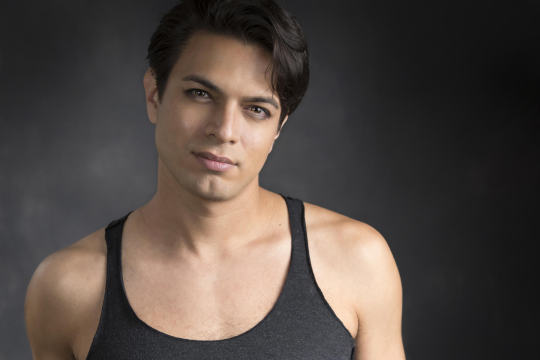
Chris Rivera (he/they) is a NYC based actor, playwright, director and Associate Artistic Director of Turn to Flesh Productions. As an actor Chris has appeared in various New York productions including King Lear, The Bacchae, The Miss Longview Texas Drag Pageant, and Oh Holy Mother of Quique. Chris also appeared in their own plays, Gender of Attraction and Our Own Odyssey, and won the FUERZAFest's best supporting actor role for the latter. Favorite regional theatre credits include leading roles in Compleat Female Stage Beauty, Phantom Tollbooth, Vampire Lesbians of Sodom, The Night Larry Kramer Kissed Me, and Hedwig and the Angry Inch for which they were named Best Actor in a Musical in the Houston Area Theater Awards. Chris currently coaches acting privately, and for the New York Film Academy. www.theactingchrisrivera.com
Ishani Kanetkar as Tori

Ishani Kanetkar (she/her) stumbled into voice acting halfway through a PhD program - and several years and a doctorate later, has completely failed to wander back out again. Among other audio drama appearances, you can hear her work on The Strange Case of Starship Iris, The Godshead Incidental, VALENCE, and Second Star to the Left, listen to her revisit the Lord of the Rings with two old friends on discussion podcast One Does Not Simply, and find her staring into the abyss on Twitter @ishanikanetkar and Tumblr @thevoicefromthestars.
Paige Alena as Leslie
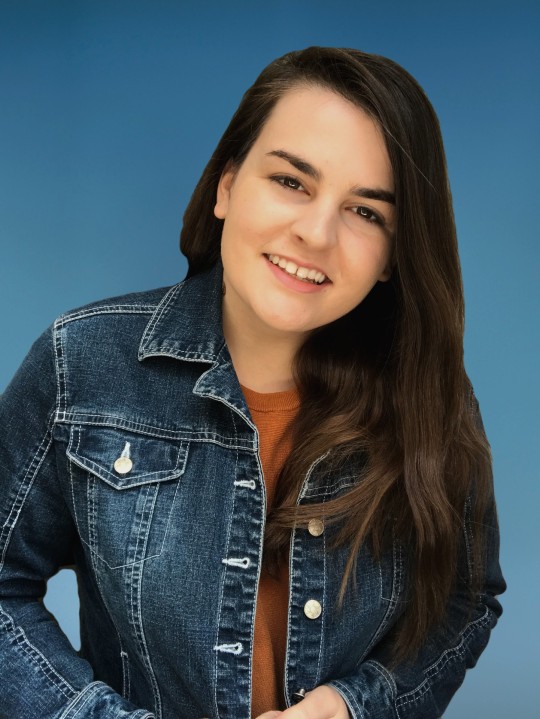
Paige Alena is an LA-based actor, writer, comedian, and singer. She's originally from the San Francisco Bay Area, but moved to New York in 2016 to earn her BFA in Acting. After graduating, she moved to Los Angeles to pursue a career in voice acting. Paige loves to create joy through her art and has a passion for making people laugh. She's a Leo, her favorite Arizona iced tea flavor is lemon, and she owns at least one mug with her own Tweet on it, but please don't hold that against her.
Regina Renée Russell as Krista

Regina is a New York based actress, writer and director. Originally hailing from the Bronx and a graduate of Cornell University (B.A. Theatre Arts) and East 15 Acting School in London (M.F.A Acting), Regina's favorite recent roles include: LCDR Talise Asherah: Primordial Deep, Trainee: Brimstone Valley Mall, Evelyn Wesley: Unwell a Midwestern Gothic Mystery, Lysistrata: Lysistrata, Lysander: A Midsummer Night’s Dream, and Helena: A Midsummer Night’s Charity Stream.
IG: reggirenee, Twitter: reginarenee594, Backstage: https://www.backstage.com/u/regina-renee-russell
Nat Razi as Ponni

Sophia Babai (they/them) is a disability rights activist, somatic coach, and freelance writer. Their writing was most recently featured in Autostraddle and the anthology BODY TALK, which was a School Library Journal Best Book of 2020. This is their first podcast and they’re so excited! Find them on Twitter @swingingstorm, TikTok @stormystoryteller, and Tumblr @masala-and-thunderstorms.
Perseus Rebelo as Andy

Perseus is a twentysomething from Toronto, Canada who can best be described as an everything enthusiast. He has performed in a number of theatre productions and short films. He also writes, reads, designs costumes, makes costumes, guides city tours, and plays an instrument or two. When he’s not doing all that, you can find him googling shark facts or taking pictures of clouds.
Nikki Paige as Mrs. Peterson

Nikki Page ages fish by day, but in her free time loves to act on stage and in audiodramas, dance hula, write books, and otherwise be part of creative chaos. She has a gangly uncoordinated greyhound named Bert and is followed by a murder of crows whenever they go walking together.
Kay Watson as the Morning Announcements
Kay Watson is a Boston-based actor and man about town. A life-long devotee of costumed shenanigans, she is also a Rennie, tabletop enthusiast, and Staff-Directed Player at Attaway Larp. Their voice can also be heard on The Strange Case of Starship Iris and Spirit Box Radio.
Also featuring
Stephen Indrisano as Eddie
Andy Emmerson as Mike
Ella Moira Seet as Melissa
143 notes
·
View notes
Text

Ida Lupino (4 February 1918 – 3 August 1995) was an English-American actress, singer, director, and producer. She is widely regarded as the most prominent female filmmaker working in the 1950s during the Hollywood studio system. With her independent production company, she co-wrote and co-produced several social-message films and became the first woman to direct a film noir with The Hitch-Hiker in 1953. Among her other directed films the best known are Not Wanted about unwed pregnancy (she took over for a sick director and refused directorial credit), Never Fear (1949) loosely based upon her own experiences battling paralyzing polio, Outrage (1950) one of the first films about rape, The Bigamist (1953) (which was named in the book 1001 Movies You Must See Before You Die) and The Trouble with Angels (1966).
Throughout her 48-year career, she made acting appearances in 59 films and directed eight others, working primarily in the United States, where she became a citizen in 1948. As an actress her best known films are The Adventures of Sherlock Holmes (1939) with Basil Rathbone, They Drive by Night (1940) with George Raft and Humphrey Bogart, High Sierra (1941) with Bogart, The Sea Wolf (1941) with Edward G. Robinson and John Garfield, Ladies in Retirement (1941) with Louis Hayward, Moontide (1942) with Jean Gabin, The Hard Way (1943), Deep Valley (1947) with Dane Clark, Road House (1948) with Cornel Wilde and Richard Widmark, While the City Sleeps (1956) with Dana Andrews and Vincent Price. and Junior Bonner (1972) with Steve McQueen.
She also directed more than 100 episodes of television productions in a variety of genres including westerns, supernatural tales, situation comedies, murder mysteries, and gangster stories. She was the only woman to direct an episode of the original The Twilight Zone series ("The Masks"), as well as the only director to have starred in an episode of the show ("The Sixteen-Millimeter Shrine").
Lupino was born in Herne Hill, London, to actress Connie O'Shea (also known as Connie Emerald) and music hall comedian Stanley Lupino, a member of the theatrical Lupino family, which included Lupino Lane, a song-and-dance man. Her father, a top name in musical comedy in the UK and a member of a centuries-old theatrical dynasty dating back to Renaissance Italy, encouraged her to perform at an early age. He built a backyard theatre for Lupino and her sister Rita (1920–2016), who also became an actress and dancer. Lupino wrote her first play at age seven and toured with a travelling theatre company as a child. By the age of ten, Lupino had memorised the leading female roles in each of Shakespeare's plays. After her intense childhood training for stage plays, Ida's uncle Lupino Lane assisted her in moving towards film acting by getting her work as a background actress at British International Studios.
She wanted to be a writer, but in order to please her father, Lupino enrolled in the Royal Academy of Dramatic Art. She excelled in a number of "bad girl" film roles, often playing prostitutes. Lupino did not enjoy being an actress and felt uncomfortable with many of the early roles she was given. She felt that she was pushed into the profession due to her family history.
Lupino worked as both a stage and screen actress. She first took to the stage in 1934 as the lead in The Pursuit of Happiness at the Paramount Studio Theatre.[10] Lupino made her first film appearance in The Love Race (1931) and the following year, aged 14, she worked under director Allan Dwan in Her First Affaire, in a role for which her mother had previously tested.[11] She played leading roles in five British films in 1933 at Warner Bros.' Teddington studios and for Julius Hagen at Twickenham, including The Ghost Camera with John Mills and I Lived with You with Ivor Novello.
Dubbed "the English Jean Harlow", she was discovered by Paramount in the 1933 film Money for Speed, playing a good girl/bad girl dual role. Lupino claimed the talent scouts saw her play only the sweet girl in the film and not the part of the prostitute, so she was asked to try out for the lead role in Alice in Wonderland (1933). When she arrived in Hollywood, the Paramount producers did not know what to make of their sultry potential leading lady, but she did get a five-year contract.
Lupino starred in over a dozen films in the mid-1930s, working with Columbia in a two-film deal, one of which, The Light That Failed (1939), was a role she acquired after running into the director's office unannounced, demanding an audition. After this breakthrough performance as a spiteful cockney model who torments Ronald Colman, she began to be taken seriously as a dramatic actress. As a result, her parts improved during the 1940s, and she jokingly referred to herself as "the poor man's Bette Davis", taking the roles that Davis refused.
Mark Hellinger, associate producer at Warner Bros., was impressed by Lupino's performance in The Light That Failed, and hired her for the femme-fatale role in the Raoul Walsh-directed They Drive by Night (1940), opposite stars George Raft, Ann Sheridan and Humphrey Bogart. The film did well and the critical consensus was that Lupino stole the movie, particularly in her unhinged courtroom scene. Warner Bros. offered her a contract which she negotiated to include some freelance rights. She worked with Walsh and Bogart again in High Sierra (1941), where she impressed critic Bosley Crowther in her role as an "adoring moll".
Her performance in The Hard Way (1943) won the New York Film Critics Circle Award for Best Actress. She starred in Pillow to Post (1945), which was her only comedic leading role. After the drama Deep Valley (1947) finished shooting, neither Warner Bros. nor Lupino moved to renew her contract and she left the studio in 1947. Although in demand throughout the 1940s, she arguably never became a major star although she often had top billing in her pictures, above actors such as Humphrey Bogart, and was repeatedly critically lauded for her realistic, direct acting style.
She often incurred the ire of studio boss Jack Warner by objecting to her casting, refusing poorly written roles that she felt were beneath her dignity as an actress, and making script revisions deemed unacceptable by the studio. As a result, she spent a great deal of her time at Warner Bros. suspended. In 1942, she rejected an offer to star with Ronald Reagan in Kings Row, and was immediately put on suspension at the studio. Eventually, a tentative rapprochement was brokered, but her relationship with the studio remained strained. In 1947, Lupino left Warner Brothers and appeared for 20th Century Fox as a nightclub singer in the film noir Road House, performing her musical numbers in the film. She starred in On Dangerous Ground in 1951, and may have taken on some of the directing tasks of the film while director Nicholas Ray was ill.
While on suspension, Lupino had ample time to observe filming and editing processes, and she became interested in directing. She described how bored she was on set while "someone else seemed to be doing all the interesting work".
She and her husband Collier Young formed an independent company, The Filmakers, to produce, direct, and write low-budget, issue-oriented films. Her first directing job came unexpectedly in 1949 when director Elmer Clifton suffered a mild heart attack and was unable to finish Not Wanted, a film Lupino co-produced and co-wrote. Lupino stepped in to finish the film without taking directorial credit out of respect for Clifton. Although the film's subject of out-of-wedlock pregnancy was controversial, it received a vast amount of publicity, and she was invited to discuss the film with Eleanor Roosevelt on a national radio program.
Never Fear (1949), a film about polio (which she had personally experienced replete with paralysis at age 16), was her first director's credit. After producing four more films about social issues, including Outrage (1950), a film about rape (while this word is never used in the movie), Lupino directed her first hard-paced, all-male-cast film, The Hitch-Hiker (1953), making her the first woman to direct a film noir. The Filmakers went on to produce 12 feature films, six of which Lupino directed or co-directed, five of which she wrote or co-wrote, three of which she acted in, and one of which she co-produced.
Lupino once called herself a "bulldozer" to secure financing for her production company, but she referred to herself as "mother" while on set. On set, the back of her director's chair was labeled "Mother of Us All".[3] Her studio emphasized her femininity, often at the urging of Lupino herself. She credited her refusal to renew her contract with Warner Bros. under the pretenses of domesticity, claiming "I had decided that nothing lay ahead of me but the life of the neurotic star with no family and no home." She made a point to seem nonthreatening in a male-dominated environment, stating, "That's where being a man makes a great deal of difference. I don't suppose the men particularly care about leaving their wives and children. During the vacation period, the wife can always fly over and be with him. It's difficult for a wife to say to her husband, come sit on the set and watch."
Although directing became Lupino's passion, the drive for money kept her on camera, so she could acquire the funds to make her own productions. She became a wily low-budget filmmaker, reusing sets from other studio productions and talking her physician into appearing as a doctor in the delivery scene of Not Wanted. She used what is now called product placement, placing Coke, Cadillac, and other brands in her films, such as The Bigamist. She shot in public places to avoid set-rental costs and planned scenes in pre-production to avoid technical mistakes and retakes. She joked that if she had been the "poor man's Bette Davis" as an actress, she had now become the "poor man's Don Siegel" as a director.
The Filmakers production company closed shop in 1955, and Lupino turned almost immediately to television, directing episodes of more than thirty US TV series from 1956 through 1968. She also helmed a feature film in 1965 for the Catholic schoolgirl comedy The Trouble With Angels, starring Hayley Mills and Rosalind Russell; this was Lupino's last theatrical film as a director. She continued acting as well, going on to a successful television career throughout the 1960s and '70s.
Lupino's career as a director continued through 1968. Her directing efforts during these years were almost exclusively for television productions such as Alfred Hitchcock Presents, Thriller, The Twilight Zone, Have Gun – Will Travel, Honey West, The Donna Reed Show, Gilligan's Island, 77 Sunset Strip, The Rifleman, The Virginian, Sam Benedict, The Untouchables, Hong Kong, The Fugitive, and Bewitched.
After the demise of The Filmakers, Lupino continued working as an actress until the end of the 1970s, mainly in television. Lupino appeared in 19 episodes of Four Star Playhouse from 1952 to 1956, an endeavor involving partners Charles Boyer, Dick Powell and David Niven. From January 1957 to September 1958, Lupino starred with her then-husband Howard Duff in the sitcom Mr. Adams and Eve, in which the duo played husband-and-wife film stars named Howard Adams and Eve Drake, living in Beverly Hills, California.[22] Duff and Lupino also co-starred as themselves in 1959 in one of the 13 one-hour installments of The Lucy–Desi Comedy Hour and an episode of The Dinah Shore Chevy Show in 1960. Lupino guest-starred in numerous television shows, including The Ford Television Theatre (1954), Bonanza (1959), Burke's Law (1963–64), The Virginian (1963–65), Batman (1968), The Mod Squad (1969), Family Affair (1969–70), The Wild, Wild West (1969), Nanny and the Professor (1971), Columbo: Short Fuse (1972), Columbo: Swan Song (1974) in which she plays Johnny Cash's character's zealous wife, Barnaby Jones (1974), The Streets of San Francisco, Ellery Queen (1975), Police Woman (1975), and Charlie's Angels (1977). Her final acting appearance was in the 1979 film My Boys Are Good Boys.
Lupino has two distinctions with The Twilight Zone series, as the only woman to have directed an episode ("The Masks") and the only person to have worked as both actor for one episode ("The Sixteen-Millimeter Shrine"), and director for another.
Lupino's Filmakers movies deal with unconventional and controversial subject matter that studio producers would not touch, including out-of-wedlock pregnancy, bigamy, and rape. She described her independent work as "films that had social significance and yet were entertainment ... base on true stories, things the public could understand because they had happened or been of news value." She focused on women's issues for many of her films and she liked strong characters, "[Not] women who have masculine qualities about them, but [a role] that has intestinal fortitude, some guts to it."
In the film The Bigamist, the two women characters represent the career woman and the homemaker. The title character is married to a woman (Joan Fontaine) who, unable to have children, has devoted her energy to her career. While on one of many business trips, he meets a waitress (Lupino) with whom he has a child, and then marries her.[25] Marsha Orgeron, in her book Hollywood Ambitions, describes these characters as "struggling to figure out their place in environments that mirror the social constraints that Lupino faced".[13] However, Donati, in his biography of Lupino, said "The solutions to the character's problems within the films were often conventional, even conservative, more reinforcing the 1950s' ideology than undercutting it."
Ahead of her time within the studio system, Lupino was intent on creating films that were rooted in reality. On Never Fear, Lupino said, "People are tired of having the wool pulled over their eyes. They pay out good money for their theatre tickets and they want something in return. They want realism. And you can't be realistic with the same glamorous mugs on the screen all the time."
Lupino's films are critical of many traditional social institutions, which reflect her contempt for the patriarchal structure that existed in Hollywood. Lupino rejected the commodification of female stars and as an actress, she resisted becoming an object of desire. She said in 1949, "Hollywood careers are perishable commodities", and sought to avoid such a fate for herself.
Ida Lupino was diagnosed with polio in 1934. The New York Times reported that the outbreak of polio within the Hollywood community was due to contaminated swimming pools. The disease severely affected her ability to work, and her contract with Paramount fell apart shortly after her diagnosis. Lupino recovered and eventually directed, produced, and wrote many films, including a film loosely based upon her travails with polio titled Never Fear in 1949, the first film that she was credited for directing (she had earlier stepped in for an ill director on Not Wanted and refused directorial credit out of respect for her colleague). Her experience with the disease gave Lupino the courage to focus on her intellectual abilities over simply her physical appearance. In an interview with Hollywood, Lupino said, "I realized that my life and my courage and my hopes did not lie in my body. If that body was paralyzed, my brain could still work industriously...If I weren't able to act, I would be able to write. Even if I weren't able to use a pencil or typewriter, I could dictate."[31] Film magazines from the 1930s and 1940s, such as The Hollywood Reporter and Motion Picture Daily, frequently published updates on her condition. Lupino worked for various non-profit organizations to help raise funds for polio research.
Lupino's interests outside the entertainment industry included writing short stories and children's books, and composing music. Her composition "Aladdin's Suite" was performed by the Los Angeles Philharmonic Orchestra in 1937. She composed this piece while on bedrest due to polio in 1935.
She became an American citizen in June 1948 and a staunch Democrat who supported the presidency of John F. Kennedy. Lupino was Catholic.
Lupino died from a stroke while undergoing treatment for colon cancer in Los Angeles on 3 August 1995, at the age of 77. Her memoirs, Ida Lupino: Beyond the Camera, were edited after her death and published by Mary Ann Anderson.
Lupino learned filmmaking from everyone she observed on set, including William Ziegler, the cameraman for Not Wanted. When in preproduction on Never Fear, she conferred with Michael Gordon on directorial technique, organization, and plotting. Cinematographer Archie Stout said of Ms. Lupino, "Ida has more knowledge of camera angles and lenses than any director I've ever worked with, with the exception of Victor Fleming. She knows how a woman looks on the screen and what light that woman should have, probably better than I do." Lupino also worked with editor Stanford Tischler, who said of her, "She wasn't the kind of director who would shoot something, then hope any flaws could be fixed in the cutting room. The acting was always there, to her credit."
Author Ally Acker compares Lupino to pioneering silent-film director Lois Weber for their focus on controversial, socially relevant topics. With their ambiguous endings, Lupino's films never offered simple solutions for her troubled characters, and Acker finds parallels to her storytelling style in the work of the modern European "New Wave" directors, such as Margarethe von Trotta.
Ronnie Scheib, who issued a Kino release of three of Lupino's films, likens Lupino's themes and directorial style to directors Nicholas Ray, Sam Fuller, and Robert Aldrich, saying, "Lupino very much belongs to that generation of modernist filmmakers." On whether Lupino should be considered a feminist filmmaker, Scheib states, "I don't think Lupino was concerned with showing strong people, men or women. She often said that she was interested in lost, bewildered people, and I think she was talking about the postwar trauma of people who couldn't go home again."
Author Richard Koszarski noted Lupino's choice to play with gender roles regarding women's film stereotypes during the studio era: "Her films display the obsessions and consistencies of a true auteur... In her films The Bigamist and The Hitch-Hiker, Lupino was able to reduce the male to the same sort of dangerous, irrational force that women represented in most male-directed examples of Hollywood film noir."
Lupino did not openly consider herself a feminist, saying, "I had to do something to fill up my time between contracts. Keeping a feminine approach is vital — men hate bossy females ... Often I pretended to a cameraman to know less than I did. That way I got more cooperation." Village Voice writer Carrie Rickey, though, holds Lupino up as a model of modern feminist filmmaking: "Not only did Lupino take control of production, direction, and screenplay, but [also] each of her movies addresses the brutal repercussions of sexuality, independence and dependence."
By 1972, Lupino said she wished more women were hired as directors and producers in Hollywood, noting that only very powerful actresses or writers had the chance to work in the field. She directed or costarred a number of times with young, fellow British actresses on a similar journey of developing their American film careers like Hayley Mills and Pamela Franklin.
Actress Bea Arthur, best remembered for her work in Maude and The Golden Girls, was motivated to escape her stifling hometown by following in Lupino's footsteps and becoming an actress, saying, "My dream was to become a very small blonde movie star like Ida Lupino and those other women I saw up there on the screen during the Depression."
Lupino has two stars on the Hollywood Walk of Fame for contributions to the fields of television and film — located at 1724 Vine Street and 6821 Hollywood Boulevard.
New York Film Critics Circle Award - Best Actress, The Hard Way, 1943
Inaugural Saturn Award - Best Supporting Actress, The Devil's Rain, 1975
A Commemorative Blue Plaque is dedicated to Lupino and her father Stanley Lupino by The Music Hall Guild of Great Britain and America and the Theatre and Film Guild of Great Britain and America at the house where she was born in Herne Hill, London, 16 February 2016
Composer Carla Bley paid tribute to Lupino with her jazz composition "Ida Lupino" in 1964.
The Hitch-Hiker was inducted into the National Film Registry in 1998 while Outrage was inducted in 2020.
#ida lupino#classic hollywood#classic movie stars#golden age of hollywood#old hollywood#1930s hollywood#1940s hollywood#1950s hollywood#1960s hollywood#1970s hollywood#hollywood legend
25 notes
·
View notes
Text
For Further Study: Joseph Cornell 🎨 🔍

I had so much fun researching the life and artwork of Joseph Cornell! His work is fascinating and nothing like I'd ever seen! I was disappointed that I couldn't include more of his work in my presentation, but I've listed some of his art below if you want to know more! ⤵️
🎨 Untitled (Penny Arcade Portrait of Lauren Bacall) (ca. 1946)
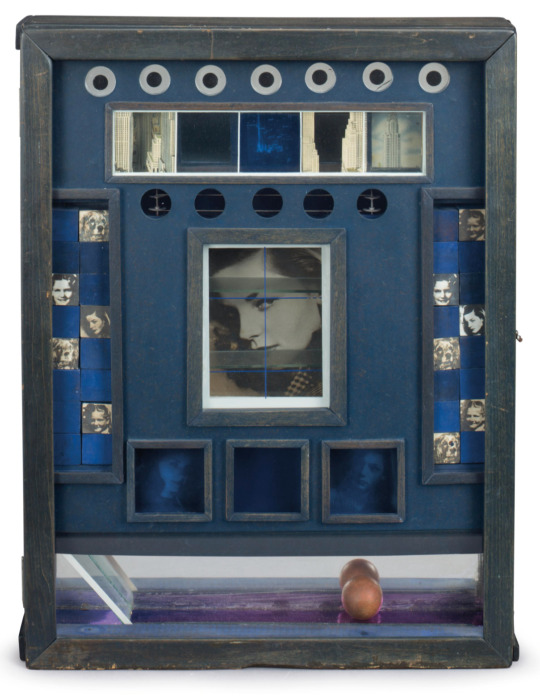
Exhibition context: First exhibited in the Hugo Gallery in New York (Dec. 1946)
Date: 1945-46
Materials: Wood, glass, paint, tinted glass, mirror, foil paper, string, thread and printed paper collage
Dimensions: 20½ x 17 x 3½ in.
To see the careful details and fun interactive-ness of this piece, watch this little video!
🎨 Cockatoo and Corks (ca. 1948)

Exhibition context: Originally exhibited in 1949 at the Charles Egan Gallery, this piece was part of the 26 boxes that comprised Cornell’s Aviary series. It now resides in a private collection.
Date: 1948
Materials: Wood, paint, glass, metal and printed paper collage, with music box
Dimensions: 14 3/8 x 13 1/2 x 5 5/8 in.
🎨 Object (Roses des vents) (ca. 1953)

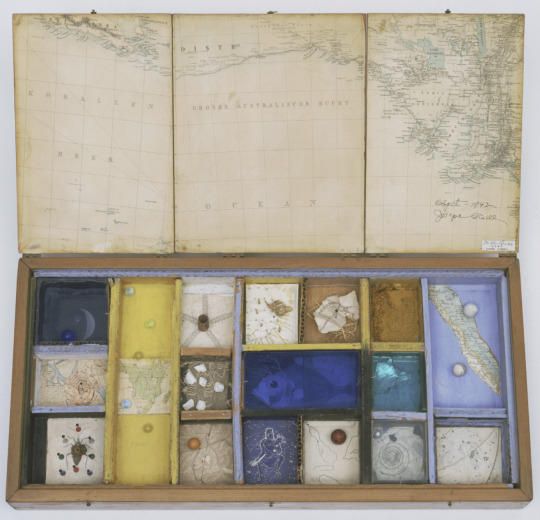
Exhibition context: Currently contained in the MoMA collection
Date: 1942-53
Materials: Wood, compasses, printed paper collage, shells, marbles
Dimensions: 2 5/8 x 21 1/4 x 10 3/8 in.
A note about this piece: “Roses des vents” means “compass dial” in French, and the title is a reference to a poem by Philippe Soupault, a friend of Cornell’s. The lid of this box is lined with maps, and mini compasses are set into a wood tray. Underneath, there are compartments with maps, diagrams of constellations, shells, marbles, a beetle and a paper fish. I just love how this box is constructed, and how it communicates the theme of travel.
🎬 Rose Hobart (ca. 1936)

Exhibition context: This film first premiered at the Julien Levy Gallery in New York
Date: 1936
Materials: Footage from East of Borneo (1931), other movie clips, Brazilian record from a thrift store
Dimensions: N/A
I wanted to also include one of Cornell’s experimental films, since I didn’t get to mention them in my presentation. This one, titled Rose Hobart after the main actress of the B-movie East of Borneo (1931), is the first film he made.
For more information about how Cornell made this video collage, and details about Salvador Dalí’s unexpected reaction to the film, visit this link from MoMA. And click here to watch the film on YouTube.
🔍 For more information on Joseph Cornell, check out these links:
1️⃣ This article from The Art Story provides a great synopsis of Joseph Cornell’s life, accomplishments, and key artworks. For anyone who just wants to dip their toes into Cornell’s background and work, this is a great resource!
2️⃣ This article from The Guardian was written during the Royal Academy of Art’s 2015 exhibition of Cornell’s work (called Joseph Cornell: Wanderlust). I found it to be a really comprehensive look at Cornell’s background, inspirations, and artwork. If you want to get to know Joseph Cornell more personally, this is a good read!
3️⃣ This 6-minute video details the Joseph Cornell pieces belonging to Ed and Lindy Bergman, who were enthusiastic collectors of Cornell’s work. The video provides a great introduction to some of his other artworks, so if you want a general overview of his art, check this one out!
1 note
·
View note
Text
2020 in review!!
Rules: answer some questions about 2020 and tag some people!
tagged by the lovely @nakey-cats-take-bathsss thank you. i adore u🥺
Top Five Films you watched in 2020:
okay do they have to be made in 2020? bc these are not and most of them i rewatched recently but they are still amazing!!! plus im not a rlly big movie watcher sorry
stardust (2007) | the princess bride | hamilton (? movie) | les mis | tombstone
Top Five TV Shows you watched in 2020:
MERLIN (again that is) | THE WITCHER | JULIE AND THE PHANTOMS | UMBRELLA ACADEMY | LEGION
they are in all caps because i love them sm
Top Five Songs of 2020:
ahhhh i dont think any of my music came out this year ansjkskaka except one (?) and its a complete soundtracks bc all bops
hamilton soundtrack (lol) | jatp soundtrack (lol) | the messenger by linkin park | wasteland, baby by hozier | patience by chris cornell
Top Five Books of 2020:
empire of storms by sjm | kingdom of ash by sjm | red queen by victoria aveyard | king’s cage by victoria aveyard | heir of fire by sjm
OKAY im sorry it’s mostly the throne of glass series...they just affected me so much and i adore them with all i have (i binged them all for the first time in two months this year ajsjakak). i just bought like five/six or so books that ill be reading soon. i also read, in 2020, the shadows between us (which was a fun binge), the selection (unpopular opinion is that i actually rlly didn’t like it LOL) and born in fire (and most of raised in fire... i burned out, unintentional pun, so i didn’t finish them but they were highly entertaining. def chilling adventures of sabrina vibe)
Top Five Fanfictions of 2020:
god okay here i go..i have so many but these five left lasting imprints on me when i read them this year:
The Warrior and The Embers by cicada-bones!! pls read it if you’ve read the throne of glass series.. it’s fucking incredible
Sanctuary by @clarkcsbellamy it feels like forever ago i read this but man,,, bellarke in this is to live for
Why Sparrows Were Outlawed in Camelot by @livinginatimeof-myths (WIP) of my all time favorite reads and the author is simply lovely and amazing.
So Says The Sword by komodobits.... first destiel fic ive ever read and it fucked me up. big time
Darkest Before the Dawn by RocknVaughn.... man this one fucked me up too. merthur is beautiful in this ajsjsks
Eight positive things/things I’m grateful for:
1. my family 🥺🥺 | 2. @teaamfreewill bc she made my year bright and amazing | 3. honestly, getting back into reading has been such a pleasure. binge reading is so much fun and im so happy i decided to do it again (albeit later in the year. next year will be more reading, hopefully) | 4. merthur.. tbh this shit brings me so much joy (so does bellarke but honestly still sore) | 5. my puppies 🐶 i love my two poms w all my heart | 6. fanfic writers because you guys are the true fucking heroes of 2020 | 7. gif/content creators because you guys are so fucking talented and deserve more praise | 8. my therapist!!! that might sound weird but it’s taken me years to find one that works for me and it is so much better now for me since i like her!!🥺
saying hello and happy new year🥺/no pressure tags: @peggysousfan @simpendragons @yourebeautifuleverylilpiecelove @slutforfruit @teaamfreewill (sorry for the double tag queen) @its-hyperfixation @igotbellarkeforthat
#ashley rambles#tag games#positivity#new years tag#rowaelin#bellarke#merthur#destiel#fanfic writers#content creators#fanfiction#long post
20 notes
·
View notes
Photo


Graduations everywhere are little different this year, but we still recognize all of the accomplishments and hard work of our high school seniors. This photograph shows the Saratoga High School class of 1907. On the back someone wrote the names of the graduates, and the colleges they were set to attend, including New York University, Cornell, Syracuse, Brown, and the New York Academy of Music.
Image from the Saratoga Room collection at the Saratoga Springs Public Library.
15 notes
·
View notes
Text
I was tagged by @whitedeadflower and @thenonatapes to answer the following questions, thank you 💕💕
1: What are you wearing? Underwear and an oversized t-shirt
2: Ever been in love? Unfortunately, yes
3: Ever had a terrible breakup? No.
4: How tall are you? 171 or 172 cm
5: How much do you weigh? 61 kg
6: Any tattoos do you want? Yesss, lately I’m seriously thinking of getting the symbol of Hakuna Matata somwhere on my hand to constantly remind myself to stop stressing out and enjoy life
7: Any piercings that you want? Not really.
8: OTP? Please excuse my ignorance, but I don’t even know what that means.
9: Favorite show? Supernatural, The Umbrella Academy, What we do in the shadows are some of the best ones I’ve watched.
10: Favorite band? Oh, this is a hard question, because my god, I’m all over the place musically, but I would say that Alice in Chains is my favourite band, even though I haven’t listened to them in months. It’s one of those bands that stick with me, and every time I hear one of their songs I’m like “yeah, that is my favourite band”
11: Something you miss? HIGHSCHOOL.
12: Favorite song? It changes a lot, but right now it’s Anthem by Greta van Fleet
13: How old are you? 19
14: Zodiac sign? Capricorn
15: Hair color? I dyed it red again yesterday.
16: Favorite quote? “Just remember, no matter how bad things get, they will always get better, unless they get worse” - I saw this one on an Instagram meme page, idk the author, but it’s so simple and obvious, and somehow comforting
17: Favorite singer? Chris Cornell, Layne Staley, Serj and Daron, Matt Bellamy
18: Favorite color? Green
19: Loud music or soft? Both, depending of my mood
20: Where do you go when you’re sad? Phisically, in a place where I can be alone so I can calm myself down and cry in peace. Mentally, I try to distract myself and not think about what makes me sad, I usually make up different universes in my head, like sometimes I think about how cool it would be if I were some kind of witch that can timetravel, but everytime I travel in time, another alternate universe gets created so I don't mess up the timeline.
21: How long does it take you to shower? 20 to 40 minutes
22: How long does it take you to get ready in the morning? About an hour
23: Ever been in a physical fight? Nope, I'm a peaceful person
24: Turn on? Great sense of humour, a person who doesn't take things too seriously, originality and a great, well-defined personality
25: Turn off? A person that says they like food and sleep as personality traits, no communication skills, close-minded people
26: The reason I joined TUMBLR? Because I saw lots of screenshots of the supernatural fandom being everywhere and being hilarious and I wanted to be a part of that lmao.
27: Fears? My biggest fear is the unstoppable passing of time, whatever you do, you can't take back the TIME, and it's scary as fuck to me that every day we are closer to the end of something.
28: Last thing that made you cry? That I'm going to start college really soon and it terrifies me.
29: Last time you cried? Three days ago for a few hours actually, it wasn't pretty...
30: Meaning behind your url? I love Stone Gossard and Mother Love Bone.
31: Last book you read? Ok, I'm gonna say it, I'm not a big book person. I don't know, reading a whole book is just stressing me out, I never do it to relax, I do it because I have to, for school, for example. I was never a big book person, and I was always embarassed by that, because reading books as a hobby was very romanticised among my former friend group when I was younger and it made me feel stupid.
32: Last song you listened to? White room by Cream. That song is a masterpiece.
33: Last show you watched? Umbrella Academy last month.
34: Last person you talked to? My mom.
35: The relationship between you and the person you last texted? He's a very good friend of mine, we are making plans to go on a really nice hill to see the sunset and the whole city with the squad.
36: Favorite food? Pizza.
37: Place you want to visit? Everywhere, the whole world, every country has beautiful places.
38: Last place you were? The living room
39: Do you have a crush? I don't even know anymore
40: Last time you kissed someone? I can't even remember, romantic relationships are not a priority for me right now. They never have been, honestly
41: Last time you were insulted and what was it? My friends call me a crazy old lady all the time, but it's in a loving way, so I don't know if it counts
42: What color underwear are you wearing? It has blue, yellow and white strips
43: What color shirt are you wearing? Blue
44: What color bottoms are you wearing? Are you talking about shoes? If so, then no color because I'm not wearing any
45: Wearing any bracelets? None atm
46: Last sport you played? I have no idea, I'm not a very sporty person
47: Last song you sang? Teenage dirtbag by Wheatus, I always go karaoke mode whenever I hear it
48: Last prank call you remember doing? Elementary school?
49: Last time you hung out with anyone? Met up outside with some friends yesterday, don't worry, we are very careful with Covid
50: Favorite movie? I don't know, I have several movies that I like, but I don't know if I would call them my favourite movie of all time. One that I recently watched and stuck with me because of the message was Swiss Army Man.
Thanks for the tag and sorry it took so long to actually do it
I'll tag @noezppl @mvickym @spreadthecurse @punk-rock-sunflowerr only if you want to, no pressure❤❤❤
6 notes
·
View notes
Text
Post # 122
Three passengers on a Kabir train
Passenger # 1 : Prahalad Singh Tipanya
In 1978, a 24-year young Dalit government school teacher in a village called Luniyakhedi in Ujjain district of Madhya Pradesh, heard the Tanpura (or Tambura) for the first time in his life and was so captivated by it that he started off on the journey of his life. His name was Prahlad Tipaniya.

Through the Tambura, Prahlad Tipaniya entered the world of Kabir. The words of this fifteenth-century saint-poet are sung in village after village by hundreds of bhajan mandalis, whose have kept alive the oral tradition of singing Kabir’s poetry for the past 600 years. Prahladji entered this world of all-night bhajan sessions as a learner. Over four decades later, he is a household name.
Prahaladji sings in a powerful Malwi style, yielding the Tanpura and the Kartal himself. His troupe consists of accompanying singers and instrumentalists playing manjira, dholak, harmonium, timki and violin. His music is not just entertaining, he connects with his audience at a spiritual level, with dialogues and simple explanations. It spreads Kabir's message - to rise above petty divisiveness, empty ritualism, and the need to adopt love as the ultimate religion.
He is a Malwa Ratna, a Sangeet Natak Academy awardee and a Padma Shree.
In 1997, Prahladji set up the Kabir Smarak Seva Shodh Sansthan (Kabir Memorial Service and Research Institute), on a plot of land granted to him by the state government adjoining his home in Lunyakhedi village. He calls this land Kabir Nagar and organizes an annual event, where thousands congregate to listen to Kabir’s words through bhajans and discourses by gathered singers and spiritual leaders.

In 2010, he started the annual Malwa Kabir Yatra, a 5-day event, which carries musicians, listeners, travelers, seekers, nomads, old, young, rich and poor together, at the same time, on the same path, making Kabir a religion of the people.

That was Passenger # 1 - Prahalad Singh Tipanya.
Passenger # 2 : Shabnam Virmani

Shabnam Virmani began her career in journalism in The Times of India, Jaipur in 1987. Just a few months later, she made history when she wrote about the infamous Roop Kanwar’s Sati, in Deorala, Rajasthan. Her article became one of the triggers for a vibrant women’s movement that led to the ban on Sati. However, she decided to quit journalism. Later, she won a scholarship to do a Masters degree in Development Communication at the Cornell University and became a film-maker. Her impactful documentaries like When Women Unite, about the successful anti-liquor movement of rural women in Andhra Pradesh and Tu Zinda Hai, which was about successful women activists of Madhya Pradesh, have won many hearts as well as prestigious awards and honors. Drishti Media, Arts, and Human Rights was co-founded by Shabnam, in 1993, in Ahmedabad, Gujarat.
In 2002, she was living in Ahmedabad, when Godhra happened. Hindus and Muslims clashed. She was dabbling with Kabir at that time. And Kabir seemed to say to her - Sadho, dekho jag bauraya- O seekers! see the world’s gone mad. And she set out on a series of journeys, camera in hand, venturing into diverse socio-cultural, religious and musical landscapes, meeting with people who sing, love, quote, revere and make meaning of Kabir. One such person, who became her guru was a Malwi musician from Madhya Pradesh - Prahalad Tipanya.
So, as though nudged by Kabir himself, she made four documentary films.
Had-Anhad: Journeys with Ram and Kabir probes the divides created by religion and nationalism.
Koi Sunta Hai: Journeys with Kumar and Kabir probes the boundaries we create in the realms of knowledge, art and music, in forms of Gharanas, and how some people like Kumar Gandharva and Kabir, challenged them and crossed-over.
Chalo Hamara Des: Journeys with Kabir and Friends shows a friendship between a rural Dalit folk singer, Prahlad Tipanya and an American scholar, Linda Hess.
Kabira Khada Bazaar Mein: Journeys with Sacred and Secular Kabir probes the ironies, compulsions and contradictions that unfold in Kabir Panthis (ones who walk the talk of Kabir).

One of her most touching endeavors is the Kabir Project. The Kabir Project is a series of journeys in quest of Kabir and other Bhakti, Sufi and Baul poets. These journeys inquire into mystic poetry of these saints through songs, images and conversations, curated through documentary films, music CDs, books, urban festivals, rural yatras, workshops and courses and a web archive called Ajab Shahar.
That was Passenger # 2 - Shabnam Virmani.
Passenger # 3 : Linda Hess

Dr. Linda Hess was, for 21 years, till she retired in 2017, a Senior Lecturer in the Department of Religious Studies, Stanford University. And she is a scholar, writer, devotee and lover of Kabir.
She was born and raised in a Jewish family. When she was 21, she "got the call" and moved to India. She says she fell in love with Kabir immediately. "He was sharp, funny, vivid and astonishing. What you didn’t want to hear, he would say—over and over, in your face. But you liked it because, really, you did want to hear it.”
She says she started reading other Bhakti poets of North India - Mirabai and Tulsi Das - but couldn't connect with their Saguni mode of Bhakti. Kabir and his Nirguni nuggets of wisdom appealed to her a lot more. She listened to the two most popular forms of Kabir poetry - Dohas and Bhajans.
The two people who touched her the most were - the same old Malwi folk singer, Prahalad Tipanya, and Kumar Gandharva. Unfortunately, she couldn't meet Kumar Gandharva in person, but after he died, she visited his family and they graciously welcomed her and gave her access to rare work of Kumar Gandharva on Kabir.
Linda Hess is best known for her book - The Bijak of Kabir - widely accepted as the best translation of Kabir poetry in English, and a couple of other books.
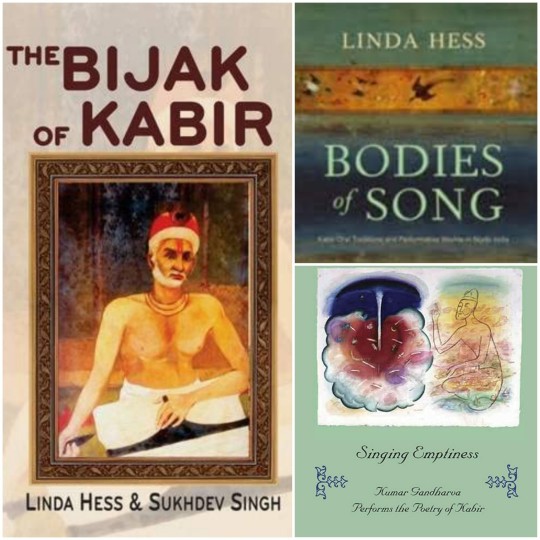
From 2002, Linda started to focus on oral traditions rather than printed texts, spending extended periods of time in India with singers. Hence began her association with Shabnam Virmani. Linda joined the Kabir project bandwagon as a consultant and has been a co-passenger ever since.
That was Passenger # 3 - Linda Hess.
These three passengers boarded the Kabir Express at different times in their lives, took some time to settle down on their berths and get to know each other. But once they did, they created some magic!
Listen to some pure, 24-carat-gold music! Have fun trying to spot Linda in the video. Of course, this video is Shabnam's Ajab Shahar production.
youtube
#kabir#prahlad singh tipanya#prahlad tipanya#lujiyakhedi#tambura#tanpura#malwi#padma shri#kabir smarakseva shodh sansthan#kABIR NAGAR#malwa kabir yatea#shabnam virmani#cornell university#godhra#documentary film#kabir project#ajab shahar#roop kanwar's sati#linda hess#stanford university#nirguni#the bijak of kabir
8 notes
·
View notes
Text
“keep it moving” | lil’ kim by mtv news, 2003.
"I'm locked in a five-year contract with [Kim]," said Cease, who's signed as a solo artist to Queen Bee Records. Other than albums that Kim herself has recorded, Cease's poor-selling but critically acclaimed 1999 solo debut, The Wonderful World of Cease A Leo, is the only release to come from the Queen Bee Records imprint since it was founded in 1998.
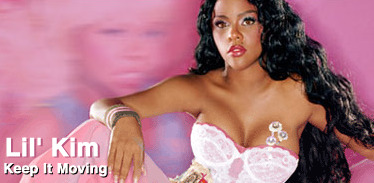
-- by Shaheem Reid, with additional reporting by Sway Calloway, Jeff Cornell and Quddus Phillipe Kimberly Jones is dying to go Hollywood, but some people are hissing that she already has. She definitely isn't the same 'round-the-way girl the Notorious B.I.G. introduced us to in 1995. Little Ms. Jones has estranged herself from old ideals and friends from her 'hood that she once considered family. She's got a fresh attitude to go with her new set of Hollywood and high-society buddies and associates, people such as Hugh Hefner, Pamela Anderson, Carmen Electra, Don King, Donatella Versace and Victoria Gotti.
Kimberly doesn't even look the same — she switches hairstyles almost as often as she changes rhyme flows. Plus she's got a new surgically altered nose to go with her voluptuous, augmented breasts. "When I decided to finally do that is when I realized I was a sex symbol," she has said about her implants. "It's something that I felt would make me have more fun with my photo shoots and enhance my look a little bit." But going Hollywood for Kim really means just that: She wants to make movies. Her dreams have nothing to do with forgetting where she came from, or — as they might say in her native Bedford Stuyvesant neighborhood — "acting brand new." Kim maintains she's the same Brooklyn girl at heart: feisty, focused and determined not to fail. Like Will Smith and, more recently, Queen Latifah, rap's Queen Bee wants to make it big in Tinsletown. Yeah, she's appeared in such flicks as "Juwanna Mann" (2002) and "Zoolander" (2001), but Kim knows she's capable of bigger roles and more explosive performances. "Being involved in different entities of the game is so much fun 'cause you don't just get stuck in one genre," she explained. "I like to be here and there. My personality and my character are versatile." But unlike the aforementioned rap legends, she still wants to keep the music industry buzzing about her material. "That's one thing I don't like," Kim said, referring to how some of her fellow MCs' music careers suffered as their movie careers took off. "Will [Smith] was doing it at one point. Regular rappers were trying to [sell] five million [albums] and he was doing seven million, with flicks out that were doing $50 million a week. That's the type of success I want to follow. I think what happens is that the rappers [who] have success in Hollywood kinda start ignoring their music. I don't think it matters to them anymore. I ain't gonna front, [if] you're getting $20 to 25 million a film ... even $10 million a film is enough to make you say, 'I don't have to do an album this year.' [But] I wouldn't do that." And that's no Hollywood talk, either. Kim not only has a movie called "Guns and Roses" due out this summer, she has a new LP, La Bella Mafia, in stores now. Named La Bella Mafia after a 1997 made-for-TV movie, "Bella Mafia," in which widows of mob figures take over the family business, this LP has been heralded as Kim's best work since her trailblazing 1996 solo debut, Hard Core. On Mafia, she runs away from the syrupy melodies and hooks that hampered 2000's Notorious K.I.M.'s "How Many Licks" and "I'm Human," which seemed to pander to radio and dancefloors. Kim's latest opus is a return to the streets, where she enlists such sound-shapers as the always-unpredictable Swizz Beatz, Scott Storch, who has co-produced some of Dr. Dre's classic jeep thumpers, and Mobb Deep's master of morose tracks, Havoc.

"She's a star, [and] people respect stars," said Havoc, who first worked with Kim on Mobb Deep's remix to "Quiet Storm." "She's smart, and most of the decisions she makes are good musically. She's among the top people in the game, and she's better than a lot of [guys]. You don't have a choice but to give her that respect." "I think she's on top of the game," concurred Queen Latifah, who recorded with Kim on the soundtrack for the Academy Award-winning film "Chicago." "I just bought her album the other day and I love it. I think it's [about] her growing up. She still ballsy, and she's still gonna pop junk to any other female rapper out there, but I like where she is right now. I like to see her in control of where she wants to go. I'm proud of her." And while Kim loves the praise she's received from her peers and fans, she feels things could still be a lot better. Although Mafia put her on pace to equal or surpass the numbers she posted with her biggest selling LP, the double platinum Hard Core (despite its lukewarm reception, Notorious K.I.M. still sold over a million copies as well), Kim wasn't pleased with La Bella Mafia's first-week sales of close to 167,000 copies. "A lot of people say 'Kim is up there,' " the Queen Bee lamented, "but I don't feel that I'm up there 'cause I haven't accomplished my goal yet, which is to sell 10 million records of one album. Imagine what people will say when I reach that point." One thing people do talk about is how long it takes Kim to churn out albums. There was a four-year gap between the first two records, and even with the widely heralded Trackmasters and the spirit of Mafia co-executive producer B.I.G. fueling this album's beats and rhymes, it took years to make as well.
"It's kind of hard because I like to take my time to make things perfect," Kim said, explaining why she always has such a long gap between projects. "I went into this album thinking, 'I'm just going to have fun with it.' I said, 'I'm going to do what I want to do. Let me do this the way I feel B.I.G would have wanted me to do this.' He's the one that taught me everything I know, and he tells me things still. That's why B.I.G is listed as the co-executive producer on my album. It's just me and him." What also slows down production is the fact that you just can't keep the black Erica Kane locked in the studio for too long. She's got her manicured hands dipped in far too many projects to be getting stuck in a sound booth all night. For one thing, she's got a new clothing line, Hollyhood, still in development, with a launch tentatively planned for the fall. A true fashion aficionado, Kim's wild outfits, trend-setting hairdos and modeling stints for Mac and Candies and have given her a strong presence in the fashion world. Hobnobbing with clothing kingpins with last names like Prada, Versace and Armani have only strengthened her cause. "When she did 'Guns and Roses,' she was on the mark," LisaRaye said of Kim's spin as Chastity, the vixen of the bunch. In addition to the movie, the two worked together on a song for the film's soundtrack. "We filmed that movie in 18 days, so you know how quick and steady the flow was," she continued. "She was actually excellent." "It was fun," Kim said with a grin. "It's like a female 'Young Guns.' Us five females, we're like sisters. When we all got together it was nothing but love. For the most part, we were all sisters on that set — we all had each other's back. I like to surround myself with good people — positive people committed to their work."
And make no mistake — if you're not committed to Kim, you can't be down. At her album release party a few weeks ago, celebrities such as Dave Chappelle, Mobb Deep, Jagged Edge and Wayne Wonder came out to one of Manhattan's newest hot spots, the Lobby, all ready to hail the Queen. Conspicuously absent were Kim's longtime running mates, Lil' Cease and the rest of the Junior M.A.F.I.A. Kim and the J.M., all friends and protégés of Biggie's, had been virtually inseparable since they were introduced back in 1995. The originally nine-member crew appeared on classic songs together, put out a gold album and performed at countless shows nationwide. When B.I.G. died, they leaned on each other during their collective time of mourning, and his memory was the glue that held them all together. And the bond was deep. When Kim went solo, she looked out for her boys as their careers stagnated. If they needed money, she hit them off. If one of her guys got in trouble with the law, as Larceny and Cease were known to do on a few occasions, Kim, the perennial mother figure, always bailed them out. At one point, the clique was so close that they all lived together in Kim's New Jersey mansion. But since then, the group's relationship has soured, and the Queen Bee has had to literally clean house. "Well, you have to move on and you have to grow," Kim said, visibly holding back venom and opting to give a more politically correct answer as to why she no longer associates with Cease and Co. "You can't be taken advantage of for too long, and it's a case where unfortunately, [the relationship] just went bad. In the same sense, I hope they do well and [that] they can find God in their hearts." On La Bella Mafia's "Heavenly Father," however, Kim's a little less restrained. She raps, "And was it enough that I split 20 percent of what I make?/ Was it enough that I cut n----s half of what I bake?"

Lil' Cease is just as angry with Kim these days as she is with him. His biggest beef with her is not that she cut him off — it's that she won't let him go. He's so miffed at his onetime homegirl that he's started a "Free Cease A Leo" T-shirt campaign.
"I'm locked in a five-year contract with [Kim]," said Cease, who's signed as a solo artist to Queen Bee Records. Other than albums that Kim herself has recorded, Cease's poor-selling but critically acclaimed 1999 solo debut, The Wonderful World of Cease A Leo, is the only release to come from the Queen Bee Records imprint since it was founded in 1998.
"She's putting all this stuff out like she's not messing with me right now," Biggie's puffy-cheeked former best friend fumed. "I feel like if you [are] not messing with me, give me walking papers so I can do me. We had our differences [and] I thought we could patch them up, but honey is doing her thing. I'm not knocking her, but she still got me under paperwork. [I've] been trying to get in touch with her, [but] she's ducking me. I call the office, [but] she don't want to talk to me. I go to the office [and] I can't see her."
"There's a lot of truth to what Cease was saying," Kim retorted with a snarl before clamming up. "I don't really want to get into that. The only thing I'm concerned with is La Bella Mafia being in stores. The whole truth will come out later and I can't wait." Although Kim is being clandestine and won't say exactly when her and the Mafia started to fall out, she is more than willing to reveal when her relationship with her former manager, mentor, friend and Notorious K.I.M.'s executive producer P. Diddy went south. "I can honestly say that during the whole process of [making Notorious K.I.M.], Puff and I were like a brother and a sister arguing," said the 26-year-old. "One minute we'd be the best of friends, and then the next minute things weren't working out at all," Kim said. "Sometimes Puffy likes people to do whatever he says. I'm a creative person, an entertainer. I'm a boss lady. A lot of times when you [are] working with a boss man, you have to respect each other's opinion. I just wanted my respect and because I was young and female, I don't think he gave it to me fully." "I'm a hard coach from beginning to end," Diddy said unapologetically about his meticulous work ethic. "I'mma push an artist to [be] the best. Some artists feel [like], 'I've grown up, and I don't want you to push me this hard no more.' I can't really do that. I'm not crazy or anything, I just want to be the best. We gotta be the best every time." Kim said she was also hurt because when times got tough for her after Notorious K.I.M. received mixed reactions, Diddy abandoned her. "I loved Puffy with all my heart, [and] if you look back, I was the only one supporting him. [At the time we were making my album] I wasn't even signed to Bad Boy," she vented. "During those times I held his hands, like, 'I know these people hate you right now, but I'm with you, dawg.' Puffy can be very selfish. I had to let him go do him and I had to go do me. I needed people at that time that was going to support me 150 percent. I was only getting 50 percent. Unfortunately, I don't speak to him at all."
P. Diddy, who seems indifferent about the split, offers a simpler explanation: "I think it's [about] people outgrowing each other and people wanting different things." While Kim hasn't cut off all her old friends, she has been gravitating toward a new crowd on the road to becoming a better-rounded person. One of her biggest cheerleaders now is Victoria Gotti, a multimedia personality and the daughter of late mob boss John Gotti. The two met over a year ago at an event in New Jersey and have built a nurturing relationship. They've done their share of partying and have at least one big adventure in common: The line-slinging siren recently held her buddy to a long-standing promise to appear in one of her videos. In February, the pair braved the bitter cold to shoot the unreleased clip for Kim's song "I Came Back For You" in front of the Brooklyn Bridge. Gotti says she'd do anything for her homie. "It's weird because she's everything she is onstage and nothing like her [persona]," Gotti said, describing why such a diverse group of people show Kim love. "She is a chameleon. She can just rise to [any] occasion and fit whatever mood everybody's in. That's the one thing I adore about Kim, [and] that's the first thing that shines through. Forget her looks, forget her outrageous outfits — she's got personality that's second to none." And what Kim's hoping for is that soon, her success in all fields will be second to none. Even as her fan base broadens, she maintains that she'll never forget the gig that first put her on to all the other opportunities. In fact, she is as hungry as ever to stand out and rock the mic. "I don't ever worry about competition," she says confidently in regards to her fellow female rappers. "I do a totally different thing from all these females. Everybody feels that 'I have to be at the top.' We can all be at the top selling records. There is no 'I'm better.' I know I'm a Queen and I do what I do.' "
And what she is doing is everything.
12 notes
·
View notes